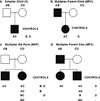Analytical methods for disease association studies with immunogenetic data
- PMID: 22665238
- PMCID: PMC4209949
- DOI: 10.1007/978-1-61779-842-9_14
Analytical methods for disease association studies with immunogenetic data
Abstract
Disease association studies involving highly polymorphic immunogenetic data may involve analyses at one or many units of analysis, including amino acid, allele, genotype and haplotype levels, as well as consideration of gene-gene or gene-environment interactions. The selection of the appropriate statistical tests is critical and will be dependent on the nature of the dataset (e.g., case-control vs. family data) as well as the specific research hypotheses being tested. This paper describes the various study and analysis categories used for such analyses, including the advantages and limitations of such techniques.
Figures

Similar articles
-
Analytical methods for immunogenetic population data.Methods Mol Biol. 2012;882:215-44. doi: 10.1007/978-1-61779-842-9_13. Methods Mol Biol. 2012. PMID: 22665237 Free PMC article.
-
In silico tools for accurate HLA and KIR inference from clinical sequencing data empower immunogenetics on individual-patient and population scales.Brief Bioinform. 2021 May 20;22(3):bbaa223. doi: 10.1093/bib/bbaa223. Brief Bioinform. 2021. PMID: 32940337 Free PMC article.
-
Bridging ImmunoGenomic Data Analysis Workflow Gaps (BIGDAWG): An integrated case-control analysis pipeline.Hum Immunol. 2016 Mar;77(3):283-287. doi: 10.1016/j.humimm.2015.12.006. Epub 2015 Dec 18. Hum Immunol. 2016. PMID: 26708359 Free PMC article.
-
BSHI Guideline: HLA matching and donor selection for haematopoietic progenitor cell transplantation.Int J Immunogenet. 2016 Oct;43(5):263-86. doi: 10.1111/iji.12282. Epub 2016 Aug 9. Int J Immunogenet. 2016. PMID: 27503599 Review.
-
14th International HLA and Immunogenetics Workshop: report of progress in methodology, data collection, and analyses.Tissue Antigens. 2007 Apr;69 Suppl 1:185-7. doi: 10.1111/j.1399-0039.2006.00767.x. Tissue Antigens. 2007. PMID: 17445197 Review.
Cited by
-
HLA-DRB1 Alleles Associated with Lower Leishmaniasis Susceptibility Share Common Amino Acid Polymorphisms and Epitope Binding Repertoires.Vaccines (Basel). 2021 Mar 17;9(3):270. doi: 10.3390/vaccines9030270. Vaccines (Basel). 2021. PMID: 33803005 Free PMC article.
-
HLA Association With AQP4-IgG-Positive Neuromyelitis Optica Spectrum Disorder in the Korean Population.Neurol Neuroimmunol Neuroinflamm. 2025 May;12(3):e200366. doi: 10.1212/NXI.0000000000200366. Epub 2025 Feb 28. Neurol Neuroimmunol Neuroinflamm. 2025. PMID: 40020215 Free PMC article.
-
High resolution HLA analysis reveals independent class I haplotypes and amino-acid motifs protective for multiple sclerosis.Genes Immun. 2019 Apr;20(4):308-326. doi: 10.1038/s41435-017-0006-8. Epub 2018 Jan 8. Genes Immun. 2019. PMID: 29307888 Free PMC article.
-
Fine-mapping of the human leukocyte antigen locus as a risk factor for Alzheimer disease: A case-control study.PLoS Med. 2017 Mar 28;14(3):e1002272. doi: 10.1371/journal.pmed.1002272. eCollection 2017 Mar. PLoS Med. 2017. PMID: 28350795 Free PMC article.
-
Increased risk of persistent neuropathic pain after traumatic nerve injury and surgery for carriers of a human leukocyte antigen haplotype.Pain. 2024 Jun 1;165(6):1404-1412. doi: 10.1097/j.pain.0000000000003143. Epub 2023 Dec 22. Pain. 2024. PMID: 38147413 Free PMC article.
References
-
- Mather KA, President M, Eastel S, Hollenbach J, Klitz W, Huttley G, Thomson G. Long distance linkage disequilibrium between HLA microsatellites in two human populations. In: Hansen JA, editor. Immunobiology of the human MHC: proceedings of the 13th international histocompatibility workshop and congress; Seattle: IHWG Press; 2007.
-
- Ann B, Begovich WK, Steiner LL, Grams S, Suraj-Baker V, Hollenbach J, Trachtenberg E, Louie L, Zimmerman PA, Hill AVS, Stoneking M, Sasazuki T, Rickards O, Titanji VPK, Konenkov VI, Sartakova ML. HLA DQ hapotypes in 15 different populations. In: Kasahara M, editor. Major histocompatibility complex: evolution, structure and function. Tokyo: Springer; 1999.
-
- Petzel-Erler ML, Gorodezky C, Layrisse Z, Klitz W, Fainboim L, Vullo C, Bodmer J, Egea E, Navarrete C, Infante E, Alaez C, Olivo A, Debaz H, Bautista N, de la Rosa G, Vazquez MN, Navarro JL, Pujol MJ, Duran C, Schafhauser C, Faucz FR, Janzen M, Maciag P, Boldt ABW, Souza PSA, Probst CM, da Silva GF, Makhatadze N, Dominguez E, Montagnani S, Matos M, Martinez A, Herrera F, Hollenbach J, Thomson G, Pando M, Satz L, Larriba J, Fernandez G, Pesoa SA, Borosky A, Garavito G, Angel L, Brown J, Llop E. Anthropology component report for region Latin-America: Amerindian and admixed populations. In: Charron D, editor. Genetic diversity of HLA: functional and medical implications. Paris: EDK Press; 1997.
-
- Trachtenberg EA, Hayes E, Hollenbach JA, Keyeaux G, Bernal J, Klitz W. HLA class II variation and linkage disequilibrium in nine Amerindian and three African American tribes from Columbia. Results of expedicion humana. In: Charron D, editor. Genetic diversity of HLA: functional and medical implications. Paris: EDK Press; 1997.
Publication types
MeSH terms
Substances
Grants and funding
LinkOut - more resources
Full Text Sources

